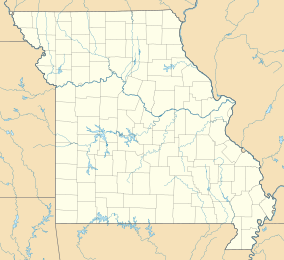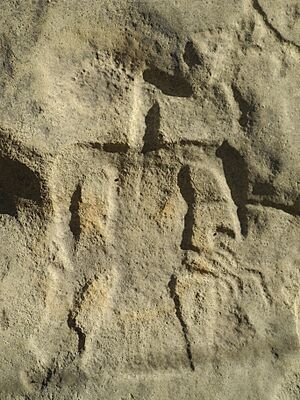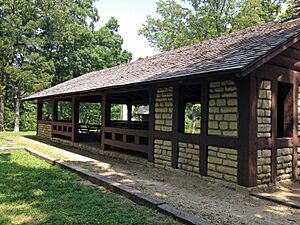Washington State Park facts for kids
Quick facts for kids Washington State Park |
|
|---|---|
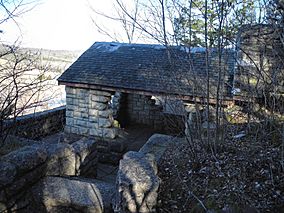
Stone shelter overlooking the Big River valley
|
|
| Location | Washington, Missouri, United States |
| Area | 2,147.57 acres (8.6909 km2) |
| Elevation | 673 ft (205 m) |
| Established | 1932 |
| Visitors | 233,424 (in 2017) |
| Governing body | Missouri Department of Natural Resources |
| Website | Washington State Park |
|
Washington State Park Petroglyph Archeological Site
|
|
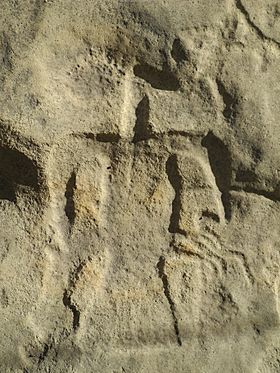
An eagle petroglyph at Washington State Park
|
|
| Nearest city | Fertile, Missouri |
| Area | 25 acres (10 ha) |
| NRHP reference No. | 70000352 |
| Added to NRHP | April 3, 1970 |
|
Washington State Park CCC Historic District
|
|
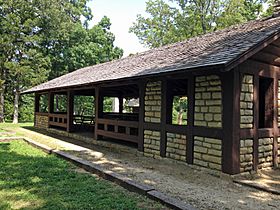
Washington State Park CCC pavilion
|
|
| Nearest city | Potosi, Missouri |
| Area | 710 acres (290 ha) |
| Built | 1934 |
| Built by | Civilian Conservation Corps |
| Architectural style | Rustic |
| MPS | ECW Architecture in Missouri State Parks 1933-1942 TR |
| NRHP reference No. | 85000517 |
| Added to NRHP | March 4, 1985 |
Washington State Park is a fun outdoor place in central eastern Missouri. It covers about 2,147 acres. You can find it on Highway 21, near the edge of the Ozarks region. This park is special for two main reasons. It has ancient rock carvings made by Native Americans. It also features beautiful stone buildings and paths built in the 1930s.
Contents
Ancient Rock Carvings: Petroglyphs
What are Petroglyphs?
Petroglyphs are pictures carved into rock. At Washington State Park, these carvings are found on hard dolomite rock. Experts believe these carvings were made a very long time ago. They were created between the years 1000 and 1600 C.E. These carvings give us clues about the lives of the Native American people who lived here.
Who Made the Carvings?
The carvings were likely made by people from the Middle Mississippi culture. These groups were related to the people who built the famous Cahokia Mounds in Illinois. It is thought that Washington State Park was a special place for ceremonies for these ancient people.
What Do the Carvings Show?
Most of the carvings show birds, arrows, and footprints. You can also see turkey tracks, human figures, and different shapes. There are over 350 symbols in the park. These carvings make up almost 75 percent of all known petroglyphs in Missouri. The sites with these carvings were added to the National Register of Historic Places in 1970.
Historic Stone Buildings and Structures
Building the Park During the Great Depression
Washington State Park was built during the Great Depression in the 1930s. This was a time when many people did not have jobs. The park was built by a group called the Civilian Conservation Corps (CCC). Company 1743, made up of African-American stonemasons, did much of the work.
The CCC's Legacy in Stone
The CCC workers were very skilled. They built many beautiful stone structures that are still used today. These include shelters for hikers and picnic areas. They also built the "1,000 Steps Trail" using many stones. There are 14 buildings and stone structures in the park that are part of the "Washington State Park CCC Historic District." This district was added to the National Register of Historic Places in 1985.
Things to Do at Washington State Park
Washington State Park offers many fun activities for visitors. You can go camping and stay overnight. Fishing and canoeing are popular in the Big River. The park also has hiking trails to explore. During warmer months, you can swim in an Olympic-sized pool or in the river.


